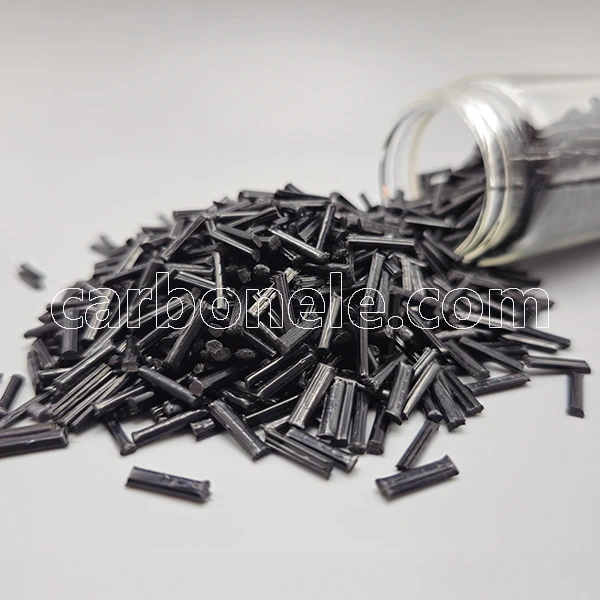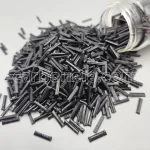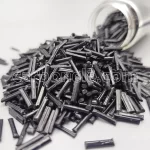
High Rigidity PEEK LCF10 for UAV Wings
PEEK LCF10 with polyether-ether-ketone and 20% long carbon fiber has high strength, good heat resistance, low friction, corrosion resistance, excellent electrical insulation and outstanding flame retardancy. Widely used in fields like aerospace.
- Manufacturer: Carbon New Material
- OEM/ODM: Acceptable
- Color: Black
- Free samples: ≤10kg
- MOQ: 100kg
- Port: Xiamen
- Model No.: PEEK-LCF-BCA1
- Matrix Resin: Polyetheretherketone
- Reinforcing Filler: Long carbon fiber
I. Introduction to PEEK LCF10 Composite Material
(I) Composition
PEEK LCF10 is a thermoplastic composite material with polyether-ether-ketone as the base material and 20% long carbon fiber as the filling material for reinforcement. This unique combination endows the material with both the high performance of PEEK and the reinforcing characteristics of carbon fiber.
(II) Performance Characteristics
1. High strength and high rigidity: The addition of long carbon fiber greatly enhances the strength and rigidity of the material. Carbon fiber has extremely high tensile strength and elastic modulus, which can effectively distribute stress, making the PEEK LCF10 composite material less prone to deformation and fracture when subjected to large loads. For example, under the same size and load conditions, components made of PEEK LCF10 composite material are several times stronger than traditional plastic components.
2. Good heat resistance: PEEK itself has excellent heat resistance and can maintain stable performance in high-temperature environments. The presence of carbon fiber further enhances the dimensional stability and mechanical properties of the material at high temperatures. This material can be used for a long time at temperatures up to 250°C, and can even withstand higher temperatures for a short time, which gives it a great advantage in high-temperature working environments.
3. Low friction coefficient: The PEEK LCF10 composite material has a low friction coefficient, which reduces wear and energy loss when used in moving parts. For example, using this material in bearings, gears and other parts can extend the service life of the parts and improve the operating efficiency of the equipment.
4. Good corrosion resistance: It can resist the erosion of various chemical substances, including acids, alkalis, organic solvents, etc. This makes it have great potential in harsh environments such as chemical industry and petroleum. Whether in corrosive media or in humid environments, the PEEK-LCF10 composite material can maintain good performance.
5. Excellent electrical insulation performance: This material has good electrical insulation performance and can effectively prevent current leakage and electrostatic accumulation. This makes it widely used in the field of electronics and electrical appliances, such as manufacturing high-performance insulating parts, circuit boards, etc.
6. Outstanding flame retardant performance: The PEEK LCF10% composite material is self-extinguishing and not easy to burn. Even in case of fire, it can be extinguished quickly without producing toxic gases. This characteristic makes it have important application value in fields with high safety requirements, such as aerospace and rail transit.
II. Application Case
In the field of aerospace, a new type of unmanned aerial vehicle (UAV) wing component adopts PEEK LCF10 composite material. This UAV has extremely high requirements for the strength, rigidity and light weight of the wing.
The high strength and high rigidity of the PEEK 10%LCF composite material ensure the stability of the wing under high-speed flight and complex airflow conditions. Compared with traditional materials, its weight is reduced by 30%, which greatly improves the endurance of the UAV. At the same time, the good heat resistance of the material enables it to adapt to the low temperature at high altitude and the high temperature near the engine. The excellent electrical insulation performance also provides reliable protection for the electronic equipment of the UAV.
During the production process, Carbon (Xiamen) New Material Company provides high-quality PEEK LCF10 composite material. Their professional technical team works closely with UAV manufacturers to customize and optimize materials according to the specific requirements of UAVs. After strict testing and verification, the composite wing components have shown excellent performance.
In terms of specific data, the wing made of PEEK+LCF10 composite material can withstand a lift force of up to 500 Newtons, and its own weight is only 70% of that of traditional metal wings. In the corrosion resistance test, after being soaked in a simulated harsh environment for 1000 hours, no obvious corrosion phenomenon appears. In addition, the low friction coefficient reduces the air resistance of the wing during flight by 15%, further improving the flight efficiency of the UAV. And the outstanding flame retardant performance also provides a strong guarantee for the flight safety of the UAV.
If you’re interested in this product, please do not hesitate to send an inquiry to us at any time.
Should you have any interest in learning more about carbon fiber reinforced thermoplastic composites, please click here.
Role of CF in PEEK LCF10
1, carbon fiber greatly enhances the strength and rigidity of the material. It has extremely high tensile strength and elastic modulus, which can effectively distribute stress and make the material less prone to deformation and fracture when subjected to large loads. 2, carbon fiber enhances the heat resistance of the material. In high-temperature environments, carbon fiber can help the material maintain dimensional stability and mechanical properties and improve the material's high-temperature working ability. In addition, carbon fiber also reduces the friction coefficient of the material, reduces wear and energy loss, prolongs the service life of the material in moving parts and improves the operating efficiency of equipment.

Frequently Asked Questions
Carbon (Xiamen) New Material Co., Ltd. aims to provide buyers with "one-stop" worry-free high-quality services. Here you can find all information about carbon fiber engineering plastics. If you still have questions, please send us an email for consultation!
-
How can I contact the manufacturer of a product that interests me?
When you find a product you are interested in, you can contact the manufacturer directly by sending an email and we will get back to you as soon as possible.
-
How do I find the products that interest me?
All you need to do is enter the keyword, product name in the search window and press the Enter key on your keyboard. Your search results page will then be displayed. You can also search within the product category pages on the home page. Each category is divided into subcategories, allowing you to refine your search and find products that interest you.
-
Where will I find a buying guide?
Please contact our after-sales service directly and we will provide you with a comprehensive operating guide.
-
What are CF Reinforced Thermoplastic Composites?
CF Reinforced Thermoplastic Composites are materials where carbon fibers are incorporated into a thermoplastic matrix. They combine the strength and stiffness of carbon fibers with the processability and recyclability of thermoplastics. For instance, they are used in automotive parts like bumper beams.
-
What are the benefits of CF Reinforced Thermoplastic Composites over traditional composites?
The key benefits include faster production cycles, easier recyclability, and better impact resistance. They also offer design flexibility. An example is in the manufacturing of consumer electronics casings where complex shapes can be achieved more easily.
-
How are CF Reinforced Thermoplastic Composites processed?
Common processing methods include injection molding, extrusion, and compression molding. Injection molding is widely used for mass production. For example, in the production of small components for the medical industry.
-
What industries use CF Reinforced Thermoplastic Composites?
They are utilized in aerospace, automotive, medical, and sports equipment industries. In aerospace, they can be found in interior components. In the medical field, they might be used in prosthetics.
-
How does the carbon fiber content affect the properties of the composites?
Higher carbon fiber content generally leads to increased strength and stiffness but may reduce ductility. A moderate content is often balanced for specific applications. For example, a higher content might be preferred in structural parts of a race car.
-
What are the challenges in using CF Reinforced Thermoplastic Composites?
Challenges include higher material costs, complex processing equipment requirements, and ensuring uniform fiber dispersion. Issues with adhesion between the fibers and the matrix can also arise. An example is in achieving consistent quality in large-scale production.






















